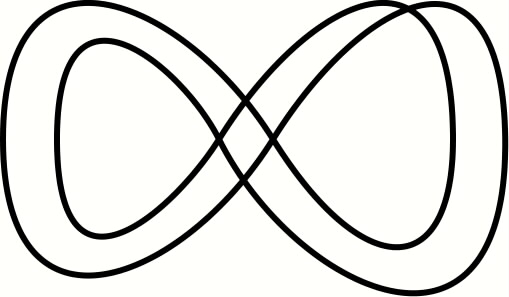CS 39: Symmetry & Topology
Lecture #9 -- Mon. 4/8, 2019.
PREVIOUS <- - - - > CS 39R HOME < - - - - > CURRENT < - - - - > NEXT
Preparation:
"Correct" your Quiz (using a
different color pen)
-- and catch up with your understanding of the course material.
Second
try to make six small 3D objects that
demonstrate these symmetries:
D1=C2; D2;
S2; D1d=C2h;
C1h=C1v; D1h=C2v.
Draw the Utility Graph and the Trefoil Knot onto a
torus.
Warm-up:
Discuss your torus models with your
neighbors.
Discuss your symmetry models with your
neighbors.
Check whether your
models have these properties:
D1=C2; -- only
one C2-axis.
D2;
-- two perpendicular C2-axes.
S2;
-- only one S2-axis.
D1d=C2h; -- one C2-axis +
mirror plane perpendicular to it.
C1h=C1v; -- one single mirror
plane.
D1h=C2v; -- two
orthogonal mirror planes + a C2-axis at their
intersection.
Chart of Cylinder
Symmetries
Collect
revised QUIZes.
Review some key concepts...
Mathematical Knots:
A wonderful, "must-have"
resource: Colin C. Adams: "The Knot Book", W. H.
Freeman and Co., New York, 1994.
Knot
Tables
Simplifying knots: Reidemeister
moves
Beautifying knots. . . -- Symmetry? Torus
Knots
Beyond knots: Links! Link
Tables
Graph Theory:
Complete Graphs.
Bipartite Graphs. (Tripartite
Graphs; Multi-partite Graphs...)
Planar Graphs.
How do Topology, Graph Theory, and Knot
Theory relate to one another?
One important connection:
What is the handle-body of lowest genus on which a particular
given graph or knot can be “embedded”, i.e., drawn without any
crossings?
==>> Homework exercises: (1) Draw the
Utility Graph onto a torus; (2) Draw the
Trefoil Knot onto a torus.
Discuss Homework Results...
Smooth Topological Deformations: "Regular Homotopies"
From static shapes to dynamically deforming
geometry:
(e.g., donut to
coffee mug; models
by H. Segerman, energy minimization):
Analyze which curves in 2D or surfaces in 3D
are transformable into one another through a "Regular
Homotopy",
i.e., a deformation that allows surface regions to pass through
one another,
but does not allow any cuts, or tears, or formation of creases
or other singular points with infinite curvature.
(With this definition, it is possible to turn a sphere or a
torus inside out -- but it is not easy!).
Let's start with curves in 2 dimensions:
Try to accomplish the following curve-shape-changes
in the plane
using a continuous smooth deformation ("regular homotopy").
Draw a sequence of
smooth key-frame shapes that would make up a continuous movie.
Change this
right-arm
"Klein-bottle profile" into a
left-arm "Klein-bottle profile". |
Simplify this
"double-8"
curve as much as possible.
|
Try to turn a
circle inside-out,
(reversing arrow direction).
|

|

|

|
Solution
Solution
Solution
Remember: You are not allowed to ever
make any sharp creases with very high curvature!
==> In the 2D plane, two smooth closed
curves can be transformed into one another,
if the
have the same "turning number"
(the number of full turns the headlights of a car would
make while driving along the curve).
Derive the turning numbers of all the curves above...
Also, simplify the Klein-bottle profile as much as possible!
These movies show regular homotopies on surfaces in 3D
space:
Torus
eversion by Cheritat (cut open,
to see inside);
Earliest approach to: Turning
a sphere inside out by Nelson Max -- (in
German!);
{ Turning a
sphere outside in by Thurston } Details Levy,
Maxwell, Munzner;
Energetically
optimal sphere eversion by Sullivan, Francis, Levy.
A
summary of the key
steps in Morin's
sphere
eversion.
Snowsculpting
("Turning a Snowball Inside-Out").
Course Schedule and Project Presentations.
New Homework Assignments:
Due: Monday, April 15,
2019.
Continue refining your Course Project story (send me e-mail).
Watch the eversion movies listed
above. Review Course Materials in general!
PREVIOUS
<- - - - > CS 39R
HOME < - - - - > CURRENT
< - - - - > NEXT
Page Editor: Carlo H. Séquin